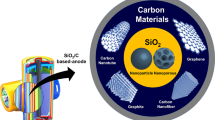Abstract
Natural vein graphite with high purity and crystallinity is seldom used as anode material in lithium-ion rechargeable batteries (LIB) due to impurities and inherent surface structure. This study focuses on improving the surface properties of purified natural vein graphite surface by employing mild chemical oxidation. Needle-platy graphite sample with initial average carbon percentage of 99.83% was improved to 99.98% after treatment with 5 vol.% HCl. Surface modification of purified graphite was done by chemical oxidation with (NH4)2S2O8 and HNO3. Fourier-transform infrared spectra of graphite after chemical indicating surface oxidation of graphite surface. X-ray diffraction and scanning electron microscopic studies show the improvement of graphite structure without modification of crystalline structure. Electrochemical performance of lithium-ion cell assembled with developed anode material shows noticeable improvement of the reversible capacity and coulombic efficiency in the first cycle and cycling behavior after surface modification.






Similar content being viewed by others
References
Wissler M (2006) Graphite and carbon powders for electrochemical applicatios. J Power Sources 156:142–150
Balogun M-S, Qiu W, Lyu F, Luo Y, Meng H, Li J, Mai W, Mai L, Tong Y (2016) All-flexible lithium ion battery based on thermally-etched porous carbon cloth anode and cathode. Nano Energy 26:446–455
Touzain P, Balasooriya N, Bandaranayake K, Descolas-Gros C (2010) Vein graphite from the Bogala and Kahatagaha–Kolongaha mines, Sri Lanka: a possible origin. Can Mineral 48:1373–1384
Dissanayaka CB, Gunawardena RP, Dinalankara DMSK (1988) Trace elements in vein graphite of Sri Lanka. Chem Geol 68:121–128
Ambrosi A, Chua CK, Khezri B, Sofer Z, Webster RD, Pumera M (2012) Chemically reduced graphene contains inherent metallic impurities present in parent natural and synthetic graphite. PNAS 109(32):899–904. https://doi.org/10.1073/pnas.1205388109
Zaghib K, Song X, Guerfi A, Rioux R, Kinoshita K (2003) Purification process of natural graphite as anode for Li-ion batteries: chemical versus thermal. J Power Sources 119-121:8–15
Lu XJ, Forssberg E (2002) Preparation of high-purity and low-sulphur graphite from Woxna fine graphite concentrate by alkali roasting. Miner Eng 15:755–757
Zhao H, Ren J, He X, Li J, Jiang C, Wan C (2007) Purification and carbon-film-coating of natural graphite as anode materials for Li-ion batteries. Electrochim Acta 52:6006–6011
Amaraweera THNG, Balasooriya NWB, Wijayasinghe HWMAC, Attanayake ANB, Dissanayake MAKL (2013) Purity enhancement of Sri Lankan vein graphite for lithium-ion rechargeable battery anode. Proceedings to 30th Technical Sessions of Geological Society of Sri Lanka, pp 101–104
Rathnayake RMNM, Wijayasinghe HWMAC, Pitawala HMTGA, Yoshimura M, Huang H-H (2017) Synthesis of graphene oxide and reduced graphene oxide by needle platy natural vein graphite. Appl Surf Sci 393:309–331
Balasooriya NWB, Touzain P, Bandaranayake PWSK (2007) Capacity improvement of mechanically and chemically treated Sri Lanka natural graphite as an anode material in Li-ion batteries. Ionics 13:305–309
Balasooriya NWB, Touzain P, Bandaranayake PWSK (2006) Lithium electrochemical intercalation into mechanically and chemically treated Sri Lanka natural graphite. J Phys Chem Solids 67:1213–1217
Hewathilake HPTS, Karunarathne N, Wijayasinghe A, Balasooriya NWB, Arof AK (2017) Performance of developed natural vein graphite as the anode material of rechargeable lithium ion batteries. Ionics 23(6):1417–1422. https://doi.org/10.1007/s11581-016-1953-1
Amaraweera THNG, Balasooriya NWB, Wijayasinghe HWMAC, Attanayake ANB, Dissanayake MAKL, Mellander B-E (2014) Development of natural Sri Lankan vein graphite as anode material for lithium ion rechargeable batteries. Proceedings of the 14th Asian Conference on Solid State Ionics (ACSSI-2014), pp 252–259
Fu LJ, Liu H, Li C, Wu YP, Rahm E, Holze R, Wu HQ (2006) Surface modifications of electrode materials for lithium ion batteries. Solid State Sci 8:113–128
Ein-Eli Y, Koch VR (1997) Chemical oxidation: a route to enhanced capacity in Li-ion graphite anodes. J Electrochem Soc 144(9):2968–2973
Wu YP, Jiang C, Wan C, Holze R (2003) Anode materials for lithium ion batteries by oxidative treatment of common natural graphite. Solid State Ionics 156:283–290
Kumar PK, Stephan AM, Thayananth P, Subramanian V, Gopukumar S, Renganathan NG (2001) Thermally oxidized graphites as anode for lithium-ion cells. J Power Sources 97-98:118–121
Placke T, Siozios V, Schmitz R, Lux SF, Bieker P, Colle C (2012) Influence of graphite surface modifications on the ratio of basal plane to “non-basal plane” surface area and on the anode performance in lithium ion batteries. J Power Sources 200:83–91
Wu YP, Jiang C, Wan C, Holze R (2003) Effects of pretreatment of natural graphite by oxidative solutions on its electrochemical performance as anode material. Electrochim Acta 48:867–874
Menachem C, Wang Y, Flowers F, Peled E, Greenbaum SG (1998) Characterization of lithiated natural graphite before and after mild oxidation. J Power Sources 76(1998):180–185
Wang H, Yoshio M (2003) Electrochemical performance of raw natural graphite flakes as an anode material for lithium-ion batteries at the elevated temperature 2003. Mater Chem Phys 79(1):76–80
Badenhorst H, Focke W (2013) Comparative analysis of graphite oxidation behaviour based on microstructure. J Nucl Mater 442:75–82
Xiaowei L, Jean-Charles R, Suyuan Y (2004) Effect of temperature on graphite oxidation behavior. Nucl Eng Des 227:273–280
Wu YP, Jianga C, Wana C, Holze R (2002) Modified natural graphite as anode material for lithium ion batteries. J Power Sources 111:329–334
Funding
This work was supported by Higher Education for Twenty First Century (HETC) grant funded by the Ministry of Higher Education Sri Lanka (grant no. UWU/O-ST/R1).
Author information
Authors and Affiliations
Corresponding author
Rights and permissions
About this article
Cite this article
Amaraweera, T.H.N.G., Balasooriya, N.W.B., Wijayasinghe, H.W.M.A.C. et al. Surface modification of natural vein graphite for the anode application in Li-ion rechargeable batteries. Ionics 24, 3423–3429 (2018). https://doi.org/10.1007/s11581-018-2523-5
Received:
Revised:
Accepted:
Published:
Issue Date:
DOI: https://doi.org/10.1007/s11581-018-2523-5




